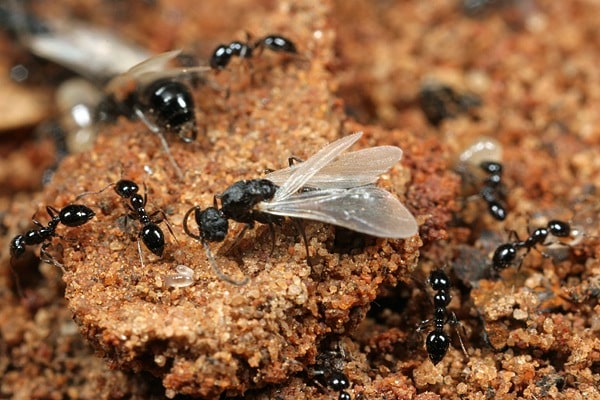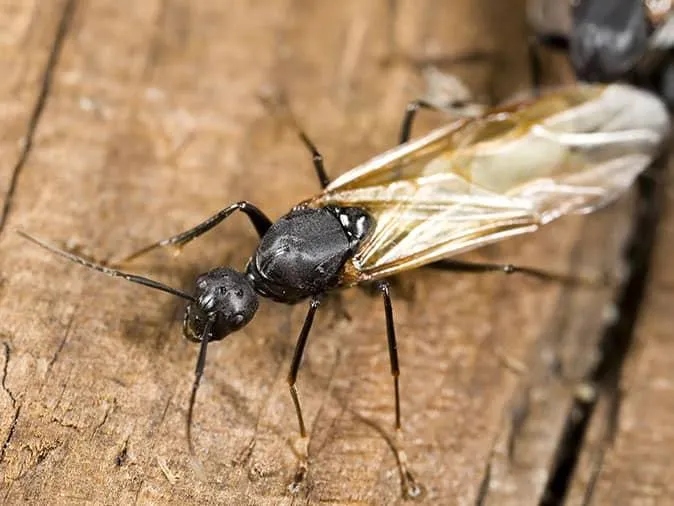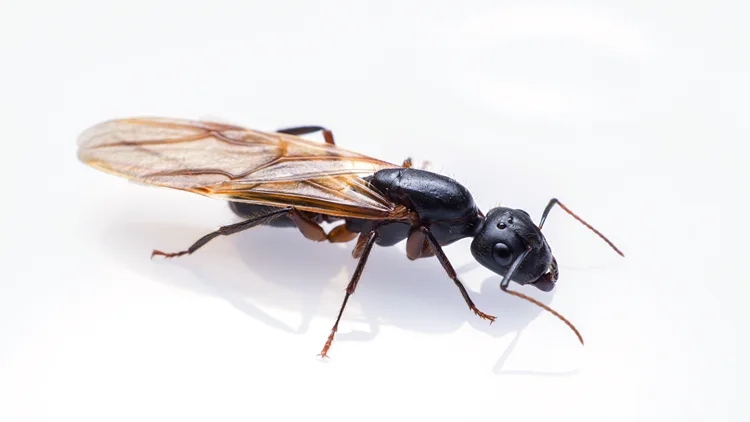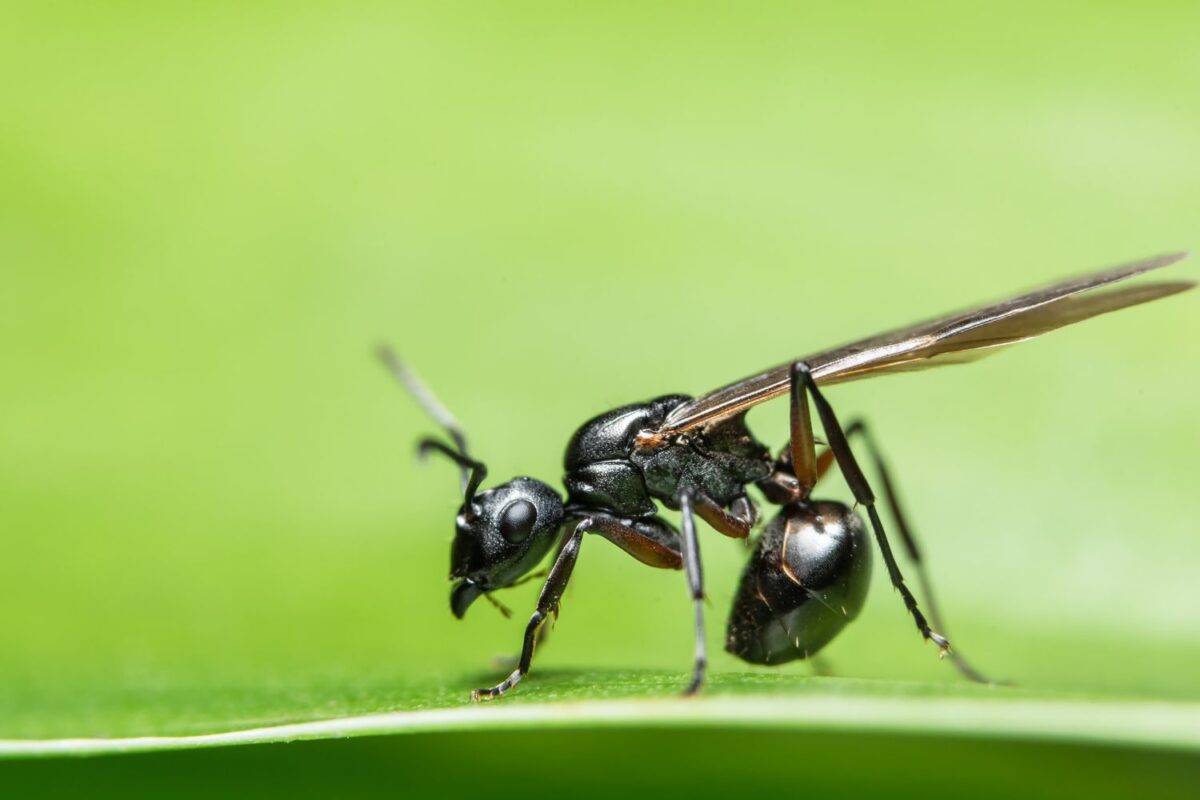In the enchanting realm of insects, ants with wings emerge as captivating creatures, adding an extraordinary dimension to the world of ants. These winged wonders, often seen during specific phases of their life cycle, signify a pivotal moment in the ant colony’s existence.
As they take to the skies, these ants embark on a unique journey, revealing a side of their behavior and biology that is both intriguing and essential to their survival.
Let’s shift our focus from the airborne spectacle to the real challenges homeowners encounter when these winged ants make their way indoors. It’s crucial to grasp their behavior to figure out effective ways to keep these unexpected guests out of our homes.
So, come along with us as we dive deep into understanding the fascinating lifecycle of ants with wings. We’re not just scratching the surface; we’re unveiling the mysteries behind their balletic existence.
More importantly, we’ll share insights on how we can peacefully coexist with these insects and prevent them from turning our homes into their unintended nests.
What are Ants With Wings Or Flying Ants?
Reproductive ants, or flying ants, are found in many different ant species. The nuptial flight is the flight performed by winged male and female ants during the mating season, which is often in the summer. They can marry and start new colonies because of this mid-air mating rite.
Similar to people, ants are diverse in size and shape, and they have several roles in a colony. Within a colony are swarmers, workers, queens, and foragers. Inside a colony, swarmers are the winged ants. Every kind of ant colony, including moisture ants and carpenter ants, has swarmers.
These Ants Fly – But Why?
These ants fly to procreate. In an ant colony, normal workers are usually infertile; only the Queen is capable of reproducing. Unlike most other ants, flying ants may reproduce and produce both male and female offspring.
Nuptial flight is the term for when these ants swarm; females fly as high as quickly as they can while males pursue them. Only the strongest and most fit ants can reach the ladies and mate thanks to the nuptial flight. Male ant swarmers die soon after mating in the air. The female ants, meantime, wander off to establish their nests and mature into queens.
The female ants shed their wings when they build a new nest. They will reabsorb the muscles used to power their wings until their kids are old enough to feed them to raise their first brood of progeny.
The remains of a queen’s wings can still be seen on the backs of larger ants. Every ant colony in the vicinity will swarm on Flying Ant Day since the weather is ideal for nuptial flight on that day.
According to a recent study, ants only flew on days when the weather was clear, and warm, and had improved from the day before. The weather is what causes the swarming. As a result, countless ants may fly around and cause a nuisance.
What Causes Flying Ants to Swarm?
Flying ants in a swarm are a sign that the colony has been developing and has not yet become visible. When virgin queens and reproductive males from other colonies of the same species clash and breed while flying through the air, it is known as a flying ant swarm.
Within the realm of insects, swarms of termites, certain types of bees, and flying ants are known as nuptial flight, which is a crucial stage in the reproductive cycle of the insect.

Why Do Flying Ants Come Into Your Home?
You have flying ants in your home for two reasons. If a few ants are visible, they most likely flew in via a window or door in search of a swarm. Before these ants can mate and establish a colony, they most likely will perish. Just remove the bag, vacuum it up, and seal any openings in screens or windows that might let other flying ants in.
You might already have a colony of flying ants in your walls or beneath the foundation if you discover a sizable swarm of them inside your house. Eliminating the ant colony is insufficient. After locating the colony, you must eliminate it using the proper medicine.
The Lifecycle Dance of Ants With Wings
The lifecycle of winged ants, also known as alates, is a captivating dance that unfolds within the intricate tapestry of the ant kingdom. This enchanting journey begins with the development of wings, signifying a pivotal stage in the life cycle of these remarkable insects. The transformation from ground-bound workers to airborne beings marks the readiness for a crucial event in the colony’s existence.
As environmental conditions become favorable, a synchronized phenomenon takes place, triggering the emergence of winged ants.
This intricate dance is not just a random occurrence; it is a precisely timed event influenced by factors such as temperature, humidity, and seasonal cues. The colony, in a remarkable display of coordination, prepares for the next phase in its lifecycle.
The emergence of winged ants is a prelude to the spectacular mating flights, a phenomenon where male and female ants take to the skies in a mesmerizing display of nature’s precision.
This aerial ballet serves a vital purpose, the reproduction and expansion of ant colonies. Observing this lifecycle dance offers a glimpse into the sophistication and harmonious rhythm of nature, where even the tiniest creatures play a crucial role in the grand symphony of life.
How Can You Keep Flying Ants Out of Your Home?
To prevent flying ants from infiltrating your home, it’s crucial to comprehend their behavior. Explore the factors that attract them indoors and gain insights into the reasons behind their presence within your living spaces.
Sealing Entry Points
The first line of defense against flying ants is to seal potential entry points. Identify and address gaps, cracks, and openings in windows, doors, and foundations. This proactive measure acts as a physical barrier, minimizing the chances of ants finding their way indoors.
Maintaining Cleanliness
Flying ants are drawn to food sources and favorable conditions. Keep your home clean by promptly cleaning up crumbs, spills, and food residue. Regularly empty trash bins and maintain a hygienic environment to discourage ants from establishing nests inside.
Proper Food Storage
Flying ants are adept at locating food sources. Ensure proper food storage by using airtight containers for pantry items. This not only denies access to potential ant feasts but also contributes to overall kitchen hygiene.
Moisture Control
Flying ants, like many pests including earwigs, bugs with pincers, and carpet bugs, are attracted to moisture. Address leaks and eliminate standing water in and around your home. Proper ventilation in damp areas like basements and crawl spaces reduces the appeal of these spaces to flying ants.
Natural Deterrents
Explore natural repellents to deter flying ants. From essential oils to vinegar solutions, incorporating these substances strategically can create an environment that flying ants find inhospitable, keeping them at bay.
Professional Pest Inspection
Consider scheduling regular pest inspections by professionals. Their expertise can identify vulnerabilities and potential infestation risks early on, allowing for preventive measures to be implemented effectively.
By combining these preventative measures, you create a robust defense against flying ants invading your home. Understanding their behavior, fortifying entry points, and maintaining a clean, inhospitable environment collectively contribute to a pest-free living space.

Interesting Facts About Ants with Wings
Flying ants are simply ants with wings
The most common ants we observe are female black ants (garden) walking around for food. During the summer, however, winged males and new queens of the same species take to the skies!
They fly to establish new ant colonies
The ants go to the skies so that queens can mate with males from other colonies and establish new nests.
Flying ants only swarm throughout the summer
Conditions must be ideal for an ant swarm to occur, which is usually induced by hot and humid weather in July or August.
The Tale of ‘Flying Ant Day’
Because so many ants appear in the same spot at the same time, the event is commonly referred to as a “flying ant day,” but it is more of a “flying ant season.” Depending on the weather, the flying insects may come anywhere in the country between June and September.
There is security in numbers
The reason the ants appear in such large numbers is to defend themselves from predators. Flying all at once also increases their chances of meeting new people.
They’re not dangerous
These flying beasties may be bothersome, but they will not harm you. They also give a lot of extra food for hungry birds!
Tennis players despise them
Flying ants invaded Wimbledon’s court in 2018, disturbing tennis players and generating headlines across the world!
Male flying ants are larger than females
Are you brave enough to look closer? Some of the winged ants are noticeably larger than others. The queens are the largest, measuring up to 15mm in length.
Queens gnaw on their wings
Queens gnaw off their wings and crawl about hunting for a new nesting site after mating. Keep an eye out for their discarded wings on the ground!
Alates are another name for flying ants
Many insects’ winged forms are referred to as alates.

Ant With Wings – FAQs
Why do some ants have wings?
Ants develop wings during specific stages of their life cycle for reproductive purposes. These winged ants are also known as alates.
When do ants with wings appear?
Ants with wings typically emerge during specific seasons, often when a colony is ready to engage in a mating flight. This event is triggered by environmental factors.
How can I naturally control ants with wings in my garden?
Use a mixture of equal parts vinegar and water to create a natural ant deterrent. Spray the solution along ant trails and entry points to discourage their presence. Additionally, consider planting ant-repelling herbs such as mint and tansy around your garden.
What organic methods can I employ to prevent flying ants from damaging my plants?
Introduce beneficial nematodes to your garden soil, which naturally prey on ant larvae. Neem oil is another organic solution; apply it to affected plants to deter ants while promoting plant health.
Are there specific plants that act as natural repellents for winged ants in gardens?
Yes, several plants can help repel winged ants organically. Planting mint, basil, or marigolds around your garden can act as natural deterrents, keeping flying ants at bay.
How can I make an organic ant-repelling spray for my garden plants?
Create a homemade ant spray by combining water, dish soap, and a few drops of essential oils such as peppermint or citrus. Spray this mixture on affected plants to repel flying ants without resorting to chemical pesticides.
What role do companion plants play in organic pest control for flying ants?
Companion planting is an effective organic strategy. Consider planting ant-repelling plants like garlic or chives near susceptible crops. These companion plants act as a natural barrier, discouraging ants and protecting your garden in an eco-friendly manner.
Final Words
Observing the intricate dance of ants with wings offers not only a visual spectacle but also a deeper understanding of the complexity and harmony within the natural world.
From the synchronized emergence of winged ants to their mid-air mating rituals, every step in their lifecycle contributes to the perpetuation and expansion of ant colonies.
As we explore preventive measures to keep flying ants out of our homes, we become active participants in the ongoing ballet of nature, fostering a coexistence that respects both the needs of these remarkable insects and our desire for a pest-free living space.



One reply on “Ants With Wings – From Aerial Ballet to Home Invasion”
[…] Costs – Eradicating book lice requires time, effort, and sometimes financial investment in pest control products or professional services, adding to the […]